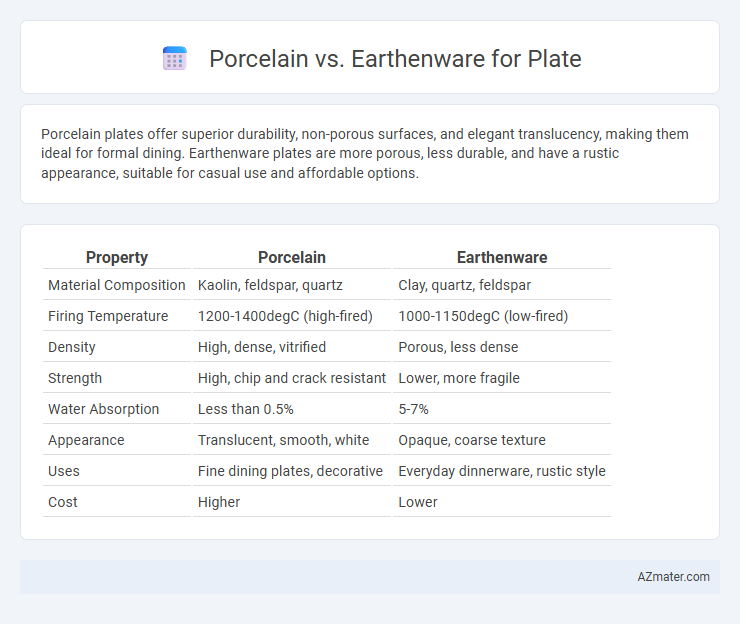Porcelain plates offer superior durability, non-porous surfaces, and elegant translucency, making them ideal for formal dining. Earthenware plates are more porous, less durable, and have a rustic appearance, suitable for casual use and affordable options.
Table of Comparison
| Property | Porcelain | Earthenware |
|---|---|---|
| Material Composition | Kaolin, feldspar, quartz | Clay, quartz, feldspar |
| Firing Temperature | 1200-1400degC (high-fired) | 1000-1150degC (low-fired) |
| Density | High, dense, vitrified | Porous, less dense |
| Strength | High, chip and crack resistant | Lower, more fragile |
| Water Absorption | Less than 0.5% | 5-7% |
| Appearance | Translucent, smooth, white | Opaque, coarse texture |
| Uses | Fine dining plates, decorative | Everyday dinnerware, rustic style |
| Cost | Higher | Lower |
Introduction to Porcelain and Earthenware Plates
Porcelain plates are crafted from refined clay fired at high temperatures, resulting in a dense, durable, and translucent finish prized for its elegance and resistance to chipping. Earthenware plates, made from clay fired at lower temperatures, have a more porous and thicker texture, offering a rustic charm but less durability compared to porcelain. Both materials provide distinctive aesthetic and functional qualities, with porcelain favored for formal dining and earthenware popular for casual, rustic table settings.
Material Composition and Manufacturing Process
Porcelain plates are made from a refined clay mixture including kaolin, feldspar, and quartz, fired at very high temperatures around 1,200 to 1,400degC, resulting in a dense, vitrified, and translucent material. Earthenware plates consist of coarser clay fired at lower temperatures, typically between 1,000 and 1,150degC, producing a more porous and opaque structure that requires glazing to be waterproof and durable. The high firing temperature and refined composition of porcelain make it stronger, chip-resistant, and suitable for fine dining, while earthenware's manufacturing process yields a heavier, more rustic feel ideal for casual settings.
Durability and Strength Comparison
Porcelain plates offer superior durability and strength compared to earthenware due to their high firing temperatures and vitrified, non-porous surface, making them resistant to chipping and cracking. Earthenware, fired at lower temperatures, tends to be more porous and fragile, often requiring glazing to improve its durability but still remains more prone to breakage. The dense composition of porcelain ensures long-lasting performance in both everyday use and formal settings, while earthenware suits decorative or light-use purposes.
Aesthetic Appeal: Colors and Finishes
Porcelain plates exhibit a smooth, glossy finish with vibrant, translucent colors that enhance intricate patterns and fine details, making them ideal for elegant table settings. Earthenware plates feature a matte or rustic finish with earthy tones and natural textures, offering a warm and handmade aesthetic. The choice between porcelain and earthenware hinges on desired color richness and surface refinement, with porcelain excelling in brightness and earthenware in organic charm.
Weight and Handling Differences
Porcelain plates are typically lighter and more delicate compared to earthenware, which is heavier and sturdier due to its coarser clay composition. The lightweight nature of porcelain makes it easier to handle and more suitable for fine dining settings, while earthenware's weight offers a robust feel but can be more cumbersome during use. Handling differences also reflect in durability; porcelain is more chip-resistant but less shock-absorbent, whereas earthenware can withstand rougher handling despite being more prone to chipping.
Heat Resistance and Microwave Safety
Porcelain plates exhibit superior heat resistance due to their dense, vitrified structure, allowing them to withstand high temperatures in ovens and microwaves without cracking or warping. Earthenware plates, made from more porous clay, have lower heat resistance and are more prone to thermal shock, making them less suitable for microwave use. Choosing porcelain ensures better durability and microwave safety, especially for frequent heating and reheating.
Porosity and Stain Resistance
Porcelain plates exhibit low porosity, making them highly resistant to liquid absorption and staining compared to earthenware, which is more porous and prone to retaining moisture and discoloration. The dense, vitrified surface of porcelain creates a non-porous barrier that enhances durability and hygiene, while earthenware's porous structure requires sealing to improve stain resistance. This difference impacts maintenance and longevity, with porcelain offering superior stain protection and ease of cleaning for everyday use.
Price and Value Considerations
Porcelain plates generally come at a higher price point due to their durability, translucency, and resistance to chipping compared to earthenware. Earthenware plates offer a more affordable option but tend to be more porous and less durable, which may impact long-term value. When considering price and value, porcelain presents a better investment for frequent use and longevity, while earthenware suits budget-conscious buyers prioritizing aesthetic appeal over durability.
Best Uses and Suitability for Different Occasions
Porcelain plates, known for their durability, non-porous surface, and elegant translucency, are best suited for formal dining, special occasions, and fine dining settings where presentation matters. Earthenware plates, with their rustic charm, thicker build, and more porous texture, excel in casual, everyday use, outdoor meals, and informal gatherings. Each material's thermal properties also influence suitability: porcelain retains heat longer for warm servings, while earthenware's heavier weight adds a sturdy feel perfect for family-style meals.
Conclusion: Choosing the Right Plate for Your Needs
Porcelain plates offer superior durability, non-porous surfaces, and elegant aesthetics, making them ideal for formal dining and frequent use. Earthenware plates provide a rustic charm and affordability but are more porous and less resistant to chipping, better suited for casual settings or decorative purposes. Selecting between porcelain and earthenware depends on balancing factors like durability, appearance, maintenance, and intended usage.

Infographic: Porcelain vs Earthenware for Plate
 azmater.com
azmater.com